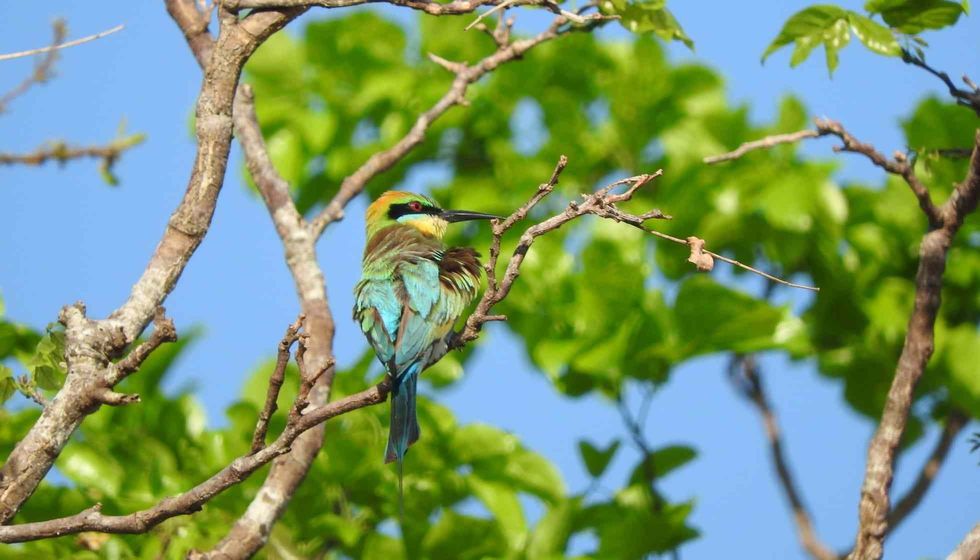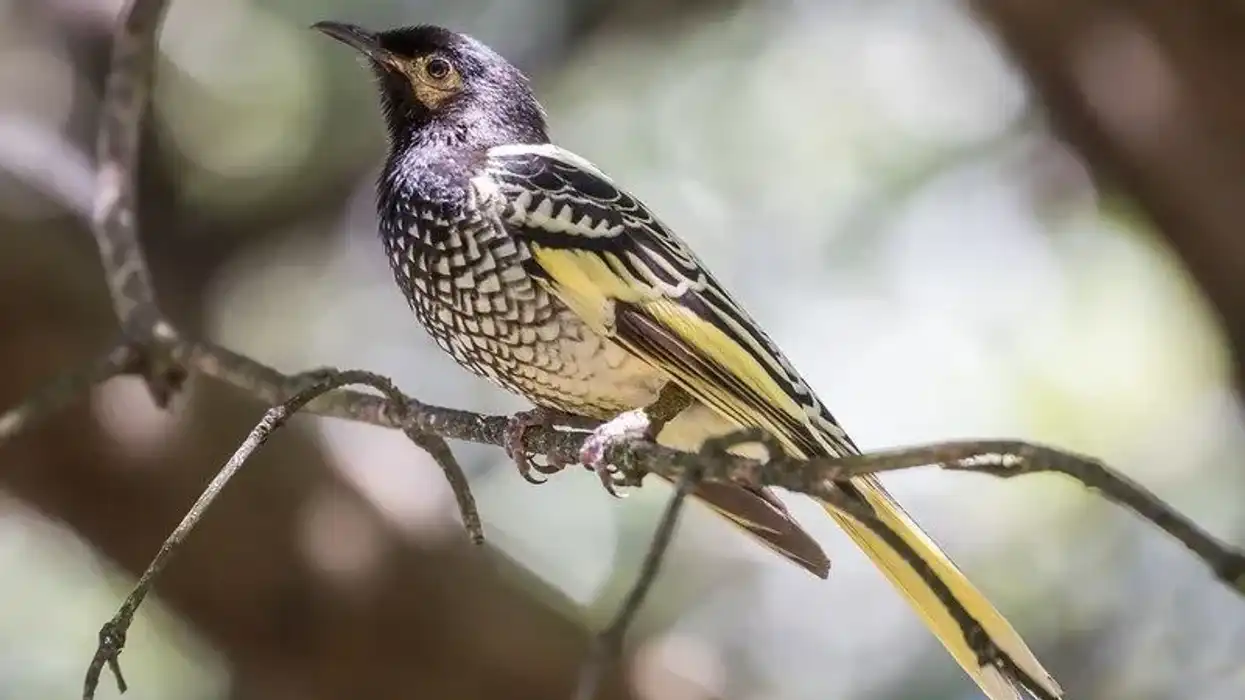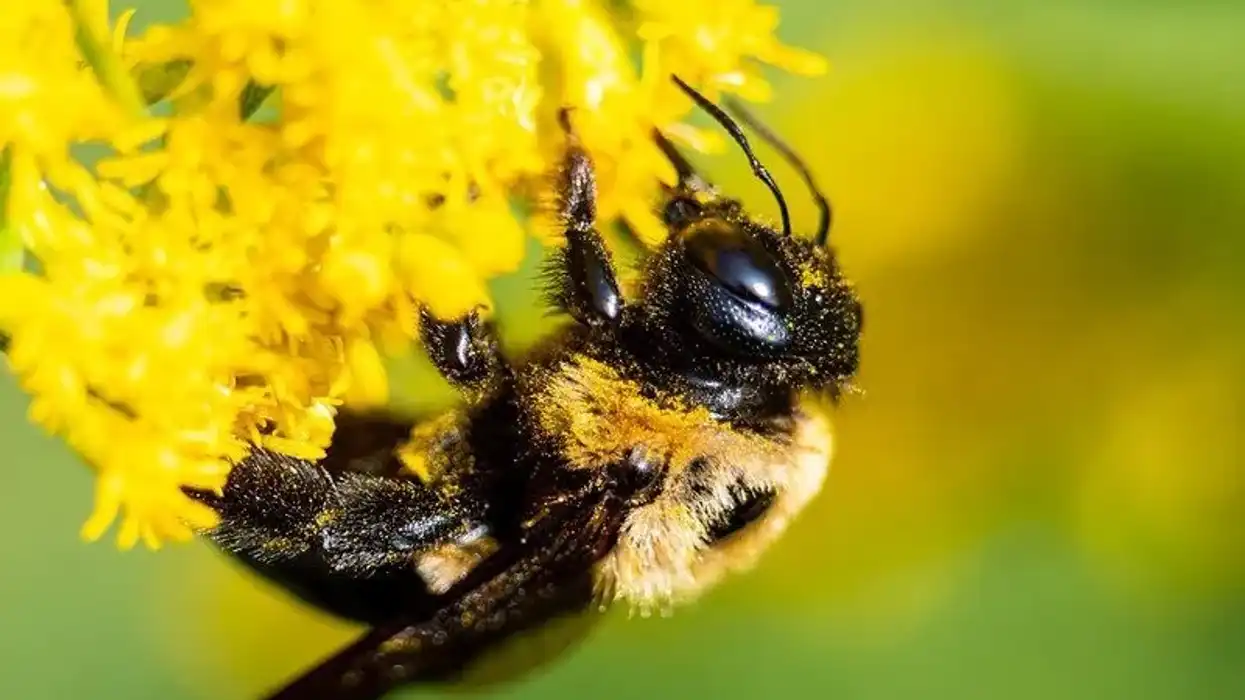The Rainbow Bee Eater known as Merops ornatus scientifically belongs to the Merops family. This bird gets its name due to the full spectrum of colors of the bird just like the rainbow.
These birds have long legs and a long downward curved bill. These birds have long tail streamers and the long tail is black.
The birds have a green breast, head, neck, and back. They have a golden crown and have a green area above the eyes and a broad black eye stripe which is bordered with a thin blue line or band.
The Rainbow Bee Eater habitat includes desert areas and it is also found in open forests usually near water sources like creeks and lakes throughout mainland Australia and the islands of Indonesia. Rainbow Bee Eaters eat flying insects such as bees and wasps and these bees and wasps tend to be venomous.
The bird builds its nesting tunnels in a suitable nesting site in a sandy area and ridge.
These birds burrow their nests instead of building them on trees. Three to seven eggs are laid in the nesting chamber.
The Rainbow Bee Eater predators include monitor lizards, yellow-footed antechinus, and cane toads. The Rainbow Bee Eater call is considered to be loud and melodious which is recognized by rapid vibrations and high pitch sound.
This species is quite beautiful and interesting to learn about so read on for facts about Rainbow Bee Eater. If you are interested, read about the bee hummingbird and burrowing owl too.
Rainbow Bee Eater Interesting Facts
What type of animal is a Rainbow Bee Eater?
Rainbow Bee-eaters are birds.
What class of animal does a Rainbow Bee Eater belong to?
The Rainbow Bee Eater belongs to the class of Aves of birds.
How many Rainbow Bee Eaters are there in the world?
There has been no specific number of Rainbow Bee Eaters in the world recorded.
Where does a Rainbow Bee Eater live?
These birds are found in the forests throughout mainland Australia and the islands of Indonesia. Since these birds do migrate, they can be found in New Guinea during the southern winter so as to avoid the cold. In springtime, they return to southern Australia ready for the breeding season.
What is a Rainbow Bee Eater's habitat?
There are various habitats inhabited by this bird depending on the regional environment available to them. The habitat includes desert areas or sandy pastures, wooded savannahs and is also found in open forests usually near water sources such as creeks or lakes, and arable lands.
In certain regions, these birds are found in bamboo grooves, palm plantations, and lowland rain forests. They are also found in parks, gardens, and clearing of logged forests in areas near civilization.
Who do Rainbow Bee Eaters live with?
As these birds are highly social, they are often found in groups or pairs.
How long does a Rainbow Bee Eater live?
The Rainbow Bee Eater lifespan is averagely around 24 months in the wild.
How do they reproduce?
Not much is known about the reproduction of these birds but is believed that these birds are socially monogamous. Their courtship rituals still remain something of a mystery, and also it is unknown whether these pairs last a lifetime or just for the mating season.
The nests are built in a suitable nesting site like ground cavities. Both the male and female build its nesting tunnels.
Burrows are made on level grounds and ridges. The breeding season varies according to the region and eggs are laid in the nesting chamber. Generally, this takes place around Australian spring, that is, September through November.
In New Guinea, eggs are laid in September while in southern Australia, eggs are laid around mid-November to December. Eggs are pearl-colored and are laid over the course of five days.
After 21-33 days, the eggs hatch. The young remain in the nests or burrows for about a month.
What is their conservation status?
The conservation status of the Rainbow Bee Eater is Least Concern.
Rainbow Bee Eater Fun Facts
What do Rainbow Bee Eaters look like?
These birds have brightly colored plumage. The wings are medium to long and it has long legs.
It has a long downward curved bill. Similar to other members of the family, these birds have long tail streamers which are elongated tail feathers and the tail is black. The bodies of these birds are green including green breast with an aqua blue rump and shiny nape and golden crown.
The wings of these birds are primarily reddish with green outer edges and dark gray tips. They have black tail feathers. They have a green area above the eyes and a broad black eye stripe which is bordered with a thin blue line or band.
These birds also tend to have yellow on their cheeks and chins. The throats have a black stripe that narrows from the midline to the shoulders.
Juveniles are slightly different in colors than adults. The back and upper regions are olive green in color. The upper throat and chin are pale yellowish in color. The other part of the throat is reddish-brown in color. Juveniles lack streamers and black stripe.

How cute are they?
These birds are considered cute because of their bright and colorful bodies.
How do they communicate?
The communication among these birds is not well documented but it is believed that members of the Meropidae family are quite vocal, calling loudly to communicate with each other. Reciprocal calling happens where one bird sings or calls and the other follows. The call is known to be a high-pitched combination of chittering and chirps.
How big is a Rainbow Bee Eater?
A Rainbow Bee Eater can be 9.1-11 in (231.1-279 mm) long and weigh up to 0.044-0.072 lb (0.02-0.033 kg).
How fast can a Rainbow Bee Eater fly?
The exact speed of the flight of this bird is unknown but these birds are known to be good flyers as they tend to chase in the air.
How much does a Rainbow Bee Eater weigh?
The Rainbow Bee Eater can weigh up to 0.044-0.072 lb (0.02-0.033 kg).
What are their male and female names of the species?
There is no specific name of the male and female of the species.
What would you call a baby Rainbow Bee Eater?
There is no particular name for a baby Rainbow Bee Eater.
What do they eat?
The Rainbow Bee Eater diet primarily includes bees and wasps. These birds also eat butterflies and moths, dragonflies, damselflies, beetles, and other flying insects.
It is believed that insects are eaten in flight but sometimes, the prey is also brought to the perch. The Rainbow Bee-Eaters capture the prey or insects on their wings flying from leafless branches to airborne insects.
Are they dangerous?
It is believed that these birds are not very dangerous to humans but are dangerous to bees as bees are its main prey and they strategically capture this prey and eat several of them in a day.
Would they make a good pet?
There is not much information available about Rainbow Bee Eaters as pets. While these birds are not aggressive towards humans and do not harm them with claws or beaks, it is believed that it is difficult to provide the appropriate habitat for these Rainbow Bee-Eaters.
Did you know...
Rainbow Bee Eaters can spot a potential prey or meal up to 45 m away.
Rainbow Bee Eaters are immune to the stings of bees, they still rub the bee's stinger against their perch to remove it and close their eyes to avoid the poison being squirted into the eyes from the poison sac, when it captures it.
Like other bee-eater birds, these birds are very social, and when they are not breeding or mating, they roost together in large groups in large trees.
The Rainbow Bee-Eaters eat around 300 wasps or bees every day. They are known to prey or hunt wasps the size of its head.
This Bee Eater species is the only bee-eater found in Australia.
The females can dig up to 1 m long tunnels or burrows site in a sandy cliff and thus, these birds are born almost underground.
These birds are considered to be extremely agile in flight and it flies swiftly and also performs various twists and turns into the air.
The Rainbow Bee Eater pairs have a single male 'helper' to assist or help to rear the young.
The Rainbow Bee Eater's adaptations
These birds have adapted to be fast fliers and can twist and turn in the air, which helps them catch the prey or small insects in the air.
Rainbow Bee Eater adaptations also include that they are immune to the stings of bees, though upon capturing a bee as prey, they will still rub the bee's stinger against their perch to remove it while closing their eyes to avoid the poison being squirted into their eyes from the poison sac.
Additionally, these birds are known to dig their nests rather than nest in trees.
These birds have adapted certain behaviors to avoid predation. When threatened, these birds tend to engage in mobbing behaviors and emit an alarm, and flies directly towards the predators. These birds also tend to nest in colonies of up to 50 pairs and it is believed that as the size of colonies increases, the predation decreases.
What is the difference between the Rainbow Bee Eater and Little Green Bee Eater?
While Rainbow Bee Eaters are only found in parts of Australia and some islands of Indonesia, the Little Green Bee Eaters are distributed widely. Both the birds look similar in color but there are very slight variations of different color shades between the two. Unlike the Rainbow Bee Eater bird, Little Green Bea Eater is a solitary nester.
Here at Kidadl, we have carefully created lots of interesting family-friendly animal facts for everyone to discover! Learn more about some other birds including macaw, or the red finch.
You can even occupy yourself at home by drawing one on our Rainbow Bee Eater coloring pages.










